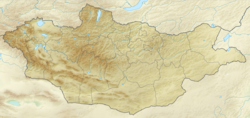Earth:Ulan Malgait Formation
| Ulan Malgait Formation Stratigraphic range: Tithonian or Oxfordian ~160–145 Ma | |
|---|---|
| Type | Geological formation |
| Sub-units | Shar Teg & Ulan Malgait Beds |
| Thickness | up to ~300 m (980 ft) |
| Lithology | |
| Primary | Mudstone |
| Other | Sandstone, conglomerate, caliche |
| Location | |
| Coordinates | [ ⚑ ] : 44°06′N 95°48′E / 44.1°N 95.8°E |
| Paleocoordinates | [ ⚑ ] 46°00′N 98°00′E / 46.0°N 98.0°E |
| Region | Govi-Altay |
| Country | |
| Type section | |
| Named for | Ulan Malgait Mountain |
The Ulan Malgait Formation is a Late Jurassic geologic formation in Mongolia. Dinosaur remains are among the fossils that have been recovered from the formation, although (As of 2004) none have yet been referred to a specific genus.[1]
It is best known for the Shar Teeg locality which has lent its name to Shartegosuchidae, a family of mesoeucrocodylians (relatives of crocodilians), many of which have been found there; Shartegosuchus (the family's type genus) means "Shar Teeg crocodile".[2] It is divided up into 2 subunits, the lower Shar Teg Beds and the upper Ulan Malgait Beds.[3]
The tritylodontids Shartegodon, Nuurtherium and Bienotheroides are known from the formation.,[4] As is docodontan Tegotherium. The turtles Annemys levensis and Annemys latiens and crocodylians Sunosuchus shartegensis and Adzhosuchus fuscus were also recovered from the formation.[5] Numerous species of insects are also known from the formation.[6][7][8][9] which was deposited in a lacustrine environment.
Age
Dollman et al. (2018) argue that the age of the Ulan Malgait Formation is likely to be Oxfordian based on the shared presence of Shartegosuchus and Nominosuchus with the radiometrically-dated Shishigou Formation of China.[10]
See also
- List of dinosaur-bearing rock formations
- List of stratigraphic units with indeterminate dinosaur fossils
References
- ↑ Weishampel et al., 2004, pp.517-607
- ↑ Dollman et al., 2018
- ↑ Watabe, 2010
- ↑ Velazco et al., 2017
- ↑ Efimov et al., 2000
- ↑ I. D. Sukacheva. 2000. New fossil caddis flies (Trichoptera) from the Shar-Teg locality in Mongolia. Paleontological Journal 34(Suppl 3):S347-S351
- ↑ "Shar-Teg, outcrop 443/1 (PIN collection 4270)". http://www.fossilworks.org/cgi-bin/bridge.pl?a=collectionSearch&collection_no=104748.
- ↑ "Shar-Teg, outcrop 423/6 (PIN collection 4270)". http://www.fossilworks.org/cgi-bin/bridge.pl?a=collectionSearch&collection_no=121394.
- ↑ "Shar-Teg, outcrop 441/4 (PIN collection 4270)". http://www.fossilworks.org/cgi-bin/bridge.pl?a=collectionSearch&collection_no=152133.
- ↑ Bor Ukhaa hills at Fossilworks.org
Bibliography
- Dollman, K. N.; J. M. Clark; M. A. Norell; X. Xu, and J. M. Choiniere. 2018. Convergent Evolution of a Eusuchian-Type Secondary Palate within Shartegosuchidae. American Museum Novitates 3901. 1–23.
- Velazco, Paúl M.; Alexandra J. Buczek, and Michael J. Novacek. 2017. Two new tritylodontids (Synapsida, Cynodontia, Mammaliamorpha) from the Upper Jurassic, southwestern Mongolia. American Museum Novitates 3874. 1–35. doi:10.1206/3874.1 hdl:2246/6698
- Watabe, Mahito. 2010. Geology of dinosaur-fossil-bearing localities(Jurassic and Cretaceous: Mesozoic) in the Gobi Desert: Results of the HMNS-MPC Joint Paleontological Expedition. Hayashibara Museum of Natural Sciences Research Bulletin 3. 41–118.
- Weishampel, David B.; Peter Dodson, and Halszka (eds.) Osmólska. 2004. The Dinosauria, 2nd edition, 1–880. Berkeley: University of California Press. Accessed 2019-02-21. ISBN:0-520-24209-2
- Efimov, M. B.; Y. M. Gubin, and S. M. Kurzanov. 2000. New primitive crocodile (Crocodylomorpha: Shartegosuchidae) from the Jurassic of Mongolia. Paleontological Journal 34. S238-S241.
Further reading
- M. Rabi, V. B. Sukhanov, V. N. Egorova, I. Danilov, and W. G. Joyce. 2014. Osteology, relationships, and ecology of Annemys (Testudines, Eucryptodira) from the Late Jurassic of Shar Teg, Mongolia, and phylogenetic definitions for Xinjiangchelyidae, Sinemydidae, and Macrobaenidae. Journal of Vertebrate Paleontology 34(2):327-352
- M. Watabe, K. Tsogtbaatar, T. Tsuihiji and R. Barsbold. 2003. The first discovery of diverse Jurassic dinosaur faunas in Mongolia. Journal of Vertebrate Paleontology 23(3, suppl.):108A
- V. B. Sukhanov. 2000. Mesozoic turtles of Middle and Central Asia. In M. J. Benton, M. A. Shishkin, D. M. Unwin, & E N. Kurichkin (eds.), The Age of Dinosaurs in Russia and Mongolia 309-367
- Y. M. Gubin and S. M. Sinitza. 1996. Shar Teg: a unique Mesozoic locality of Asia. In M. Morales (ed.), The Continental Jurassic. Museum of Northern Arizona Bulletin 60:311-318
 |


